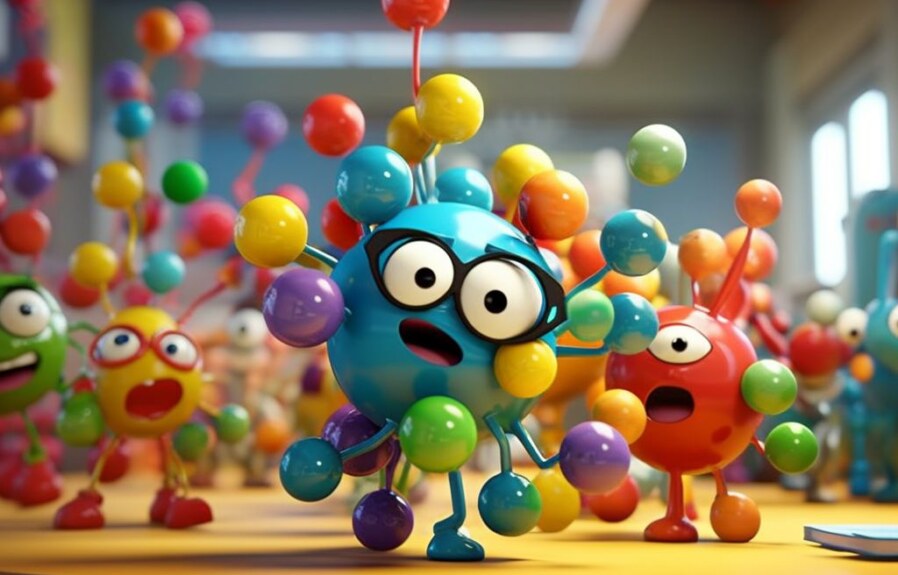Molecules, the building blocks of matter, are essential to our lives. They contain atoms that are bonded together in different ways, forming either polar or nonpolar molecules. Polar molecules have a unique property of having a slight electrical charge separation between their different atoms, while nonpolar molecules have no such charge separation. Knowing whether a molecule is polar or not is essential in understanding its properties and how it interacts with other molecules. This informative article will guide you through the fundamentals of polar and nonpolar molecules, and how to tell if a molecule is polar using various methods.
1. Understanding Molecules: What Does Polar Mean?
Before we dive into the specifics of how to tell if a molecule is polar, it is important to first understand what we mean by polar.
Simply put, a polar molecule is one in which the electron density is unevenly distributed. This means that there is a partial positive charge on one end of the molecule, and a partial negative charge on the other. This phenomenon is caused by differences in electronegativity, which is the ability of an atom to attract electrons.
When two atoms with different electronegativities bond, the more electronegative atom will pull the electrons closer to itself, creating a partial negative charge. The less electronegative atom will have a partial positive charge.
This uneven distribution of charge in a molecule is what makes it “polar.” In contrast, a nonpolar molecule has an even distribution of charge, with no distinct positive or negative ends.
2. Polar vs Nonpolar Molecules: How are they Different?
Before diving into the specifics of what makes a molecule polar, let’s first understand the difference between polar and nonpolar molecules.
Polar molecules have a slight positive charge on one side and a slight negative charge on the other side, due to differences in electronegativity of the atoms in the molecule. This charge separation creates a permanent dipole moment. Nonpolar molecules, on the other hand, have an even distribution of electrons, resulting in no net dipole moment.
For example, the water molecule (H2O) is polar, while carbon dioxide (CO2) is nonpolar. In water, the oxygen atom is more electronegative than the hydrogen atoms, resulting in a partial negative charge on the oxygen and partial positive charges on the hydrogens. In carbon dioxide, the distribution of electrons is even between the carbon and oxygen atoms, resulting in a nonpolar molecule.
3. The Role of Electronegativity in Polar Molecules
Electronegativity is one of the essential concepts in determining whether a molecule is polar or not. It is defined as the ability of an atom to attract electrons towards itself when forming a chemical bond with another atom. The higher the electronegativity value, the more likely it is for the atom to attract the shared electrons towards itself.
In a polar molecule, the atoms have an unequal distribution of electrons, resulting in a partial positive and negative charge on opposite ends of the molecule. This charge distribution occurs due to the varying electronegativity values between the atoms involved in the bond formation.
A common example of a polar molecule is water, which has oxygen bonded with two hydrogen atoms. Oxygen has a higher electronegativity value than hydrogen, resulting in the oxygen atom attracting the shared electrons closer to itself, making the molecule partially negative on the oxygen side and partially positive on the hydrogen side.
It is vital to note that not all molecules with polar bonds are polar molecules. To determine if the molecule is polar, we need to take into consideration the molecular shape, which will be discussed in detail in the next section.
4. Identifying Polar Molecules: The Dipole Moment Explained
Polar molecules have a dipole moment. A dipole moment is a measure of the separation of positive and negative charges within a molecule. When there is an unequal distribution of electrons due to differences in electronegativity, a dipole moment arises, and the molecule becomes polar.
To determine the dipole moment of a molecule, you must first identify the bond polarity. If the polarity of the molecule is relatively equal, it is nonpolar, but if it is uneven, it is polar. A bond’s polarity is determined by comparing the electronegativity of the two atoms bonded together.
When calculating dipole moments, you must consider the vector sum of all the bond dipoles in the molecule. A bond dipole is a measure of the polarity of a specific bond, and it is calculated by subtracting the electronegativity of the bonded atoms.
For example, in a water molecule, the oxygen atom is more electronegative than the hydrogen atoms, creating two polar bonds. The dipole moment of water is the vector sum of these polar bonds, which results in a net dipole moment, making water a polar molecule.
In conclusion, understanding the dipole moment is an essential step in identifying polar molecules. Calculating it involves analyzing the bond polarity and vector sum to determine if the molecule has an uneven distribution of electrons.
5. Using Molecular Shape to Determine Polarity
Determining the shape of a molecule is an important step in identifying its polarity. The arrangement of atoms in a molecule influences how the molecule interacts with other substances, making it either polar or nonpolar. Understanding molecular geometry is crucial in determining a molecule’s properties and behavior.
Molecular Geometry Basics
Molecular geometry refers to the spatial arrangement of atoms in a molecule. The basic shapes of molecules are determined by the number of atoms and the presence of lone pairs of electrons. The shape of a molecule is dictated by the repulsion forces between electron pairs, which tend to position themselves as far apart as possible.
The arrangement of electrons and atoms results in different shapes, such as linear, bent, triangular planar, tetrahedral, and trigonal bipyramidal. These shapes are associated with different properties, including polarity.
How Shape Determines Polarity
The shape of a molecule plays a significant role in determining its polarity. The presence of polar bonds in a molecule does not always mean that the molecule is polar. The overall shape of the molecule must be taken into account.
Symmetrical molecules are nonpolar, while asymmetric molecules are polar. If the electronegativities of the atoms in a molecule are different, they will create an unequal distribution of charge, leading to a polar molecule. For example, a bent shape can lead to a polar molecule, even when the electronegativity of the atoms in the bond is the same.
In conclusion, the shape of a molecule is crucial in determining its properties, including polarity. The arrangement of atoms in a molecule results in different shapes that can affect the behavior of the molecule when interacting with other substances. By understanding molecular geometry, scientists can predict the properties and behavior of different molecules.
People Also Ask
What does it mean for a molecule to be polar?
When a molecule has an unequal sharing of electrons between its atoms, it becomes polar. This means that one end of the molecule will have a slight positive charge, while the other end will have a slight negative charge.
How does electronegativity affect polarity?
Electronegativity is the ability of an atom to attract electrons towards itself. If there is a difference in electronegativity between two atoms in a molecule, then the molecule will become polar. The atom with the higher electronegativity will attract electrons and become slightly negative, while the other atom will become slightly positive.
What is the difference between polar and nonpolar molecules?
The key difference between polar and nonpolar molecules is the distribution of electrons. Polar molecules have an unequal distribution of electrons between its atoms, causing one end to be slightly positive and the other end to be slightly negative. Nonpolar molecules, on the other hand, have an equal distribution of electrons.
How can you determine if a molecule is polar or nonpolar?
To determine if a molecule is polar, you need to look at the electronegativity of the atoms present in the molecule. If the difference in electronegativity is greater than 0.5, then the molecule is polar. You can also check the symmetry of the molecule, as symmetrical molecules tend to be nonpolar.
What are some examples of polar molecules?
Water (H2O), ammonia (NH3), and hydrogen fluoride (HF) are some examples of polar molecules. These molecules have an unequal distribution of electrons due to the differences in electronegativity between the atoms they are composed of.
Conclusion
Determining if a molecule is polar or nonpolar is an important concept in chemistry. It helps in understanding the physical and chemical properties of the molecule, as well as its interactions with other molecules. By looking at the electronegativity of its atoms and the symmetry of the molecule, you can determine if it is polar or nonpolar.



